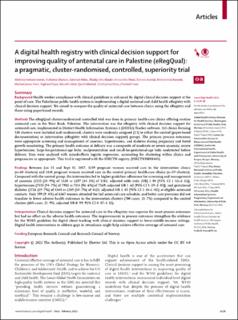| dc.contributor.author | Venkateswaran, Mahima | |
| dc.contributor.author | Ghanem, Buthaina | |
| dc.contributor.author | Abbas, Eatimad | |
| dc.contributor.author | Abu Khader, Khadija | |
| dc.contributor.author | Abu Ward, Itimad | |
| dc.contributor.author | Awwad, Tamara | |
| dc.contributor.author | Baniode, Mohammad | |
| dc.contributor.author | Frost, Michael James | |
| dc.contributor.author | Hijaz, Taghreed | |
| dc.contributor.author | Isbeih, Mervett | |
| dc.contributor.author | Mørkrid, Kjersti | |
| dc.contributor.author | Rose, Christopher James | |
| dc.contributor.author | Frøen, Frederik | |
| dc.date.accessioned | 2022-04-29T12:44:50Z | |
| dc.date.available | 2022-04-29T12:44:50Z | |
| dc.date.created | 2022-01-26T10:03:36Z | |
| dc.date.issued | 2022 | |
| dc.identifier.issn | 2589-7500 | |
| dc.identifier.uri | https://hdl.handle.net/11250/2993441 | |
| dc.description.abstract | Background
Health worker compliance with clinical guidelines is enhanced by digital clinical decision support at the point of care. The Palestinian public health system is implementing a digital maternal and child health eRegistry with clinical decision support. We aimed to compare the quality of antenatal care between clinics using the eRegistry and those using paper-based records.
Methods
The eRegQual cluster-randomised controlled trial was done in primary health-care clinics offering routine antenatal care in the West Bank, Palestine. The intervention was the eRegistry with clinical decision support for antenatal care, implemented in District Health Information Systems 2 (DHIS2) Tracker software. 133 clinics forming 120 clusters were included and randomised; clusters were randomly assigned (1:1) to either the control (paper-based documentation) or intervention (eRegistry with clinical decision support) groups. The primary process outcomes were appropriate screening and management of anaemia, hypertension, and diabetes during pregnancy and foetal growth monitoring. The primary health outcome at delivery was a composite of moderate or severe anaemia; severe hypertension; large-for-gestational-age baby; malpresentation and small-for-gestational-age baby undetected before delivery. Data were analysed with mixed-effects logistic regression, accounting for clustering within clinics and pregnancies as appropriate. This trial is registered with the ISRCTN registry (ISRCTN18008445).
Findings
Between Jan 15 and Sept 15, 2017, 3219 pregnant women received care in the intervention clinics (n=60 clusters) and 3148 pregnant women received care in the control primary health-care clinics (n=59 clusters). Compared with the control group, the intervention led to higher guideline adherence for screening and management of anaemia (1535 [28·9%] of 5320 vs 2297 [44·3%] of 5182; adjusted odds ratio [OR] 1·88 [95% CI 1·52–2·32]), hypertension (7555 [94·7%] of 7982 vs 7314 [96·6%] of 7569; adjusted OR 1·62 [95% CI 1·29–2·05]), and gestational diabetes (1726 (39·7%) of 4348 vs 2189 (50·7%) of 4321; adjusted OR 1·45 [95% CI 1·14–1·83]) at eligible antenatal contacts. Only 599 (9·4%) of 6367 women attended the full antenatal care schedule, and better care provision did not translate to fewer adverse health outcomes in the intervention clusters (700 cases; 21·7%) compared to the control clusters (688 cases; 21·9%; adjusted OR 0·99; 95% CI 0·87–1·12).
Interpretation
Clinical decision support for antenatal care in the eRegistry was superior for most process outcomes but had no effect on the adverse health outcomes. The improvements in process outcomes strengthen the evidence for the WHO guideline for digital client tracking with clinical decision support in lower-middle-income settings. Digital health interventions to address gaps in attendance might help achieve effective coverage of antenatal care. | en_US |
| dc.language.iso | eng | en_US |
| dc.publisher | Elsevier | en_US |
| dc.rights | Navngivelse 4.0 Internasjonal | * |
| dc.rights.uri | http://creativecommons.org/licenses/by/4.0/deed.no | * |
| dc.title | A digital health registry with clinical decision support for improving quality of antenatal care in Palestine (eRegQual): a pragmatic, cluster-randomised, controlled, superiority trial | en_US |
| dc.type | Journal article | en_US |
| dc.type | Peer reviewed | en_US |
| dc.description.version | publishedVersion | en_US |
| dc.rights.holder | Copyright 2022 The Author(s) | en_US |
| cristin.ispublished | true | |
| cristin.fulltext | original | |
| cristin.qualitycode | 1 | |
| dc.identifier.doi | 10.1016/S2589-7500(21)00269-7 | |
| dc.identifier.cristin | 1990135 | |
| dc.source.journal | The Lancet Digital Health | en_US |
| dc.source.pagenumber | e126-e136 | en_US |
| dc.identifier.citation | The Lancet Digital Health. 2022, 4 (2), e126-e136. | en_US |
| dc.source.volume | 4 | en_US |
| dc.source.issue | 2 | en_US |

